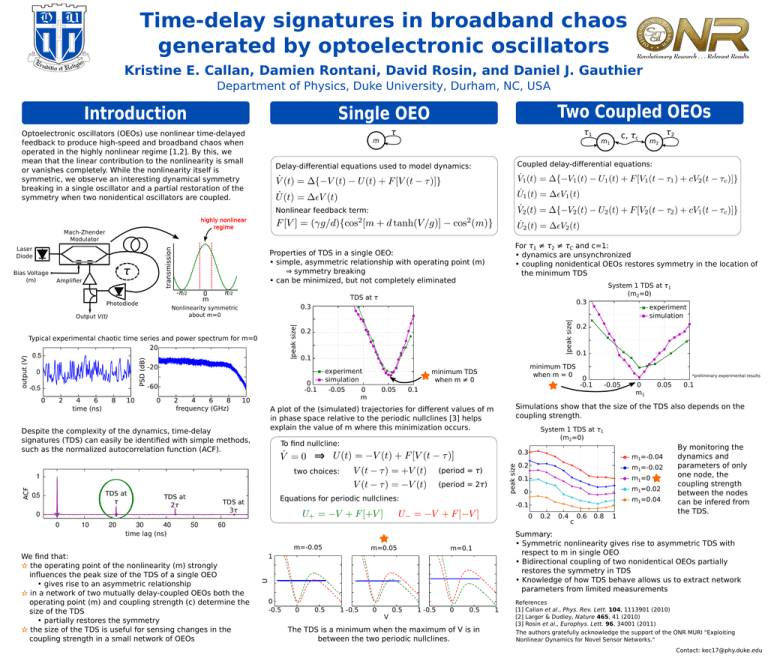Time-delay signatures in broadband chaos generated by optoelectronic oscillators Two Coupled OEOs Introduction
advertisement

Time-delay signatures in broadband chaos generated by optoelectronic oscillators Kristine E. Callan, Damien Rontani, David Rosin, and Daniel J. Gauthier Department of Physics, Duke University, Durham, NC, USA Introduction Two Coupled OEOs Single OEO τ1 τ Optoelectronic oscillators (OEOs) use nonlinear time-delayed feedback to produce high-speed and broadband chaos when operated in the highly nonlinear regime [1,2]. By this, we mean that the linear contribution to the nonlinearity is small or vanishes completely. While the nonlinearity itself is symmetric, we observe an interesting dynamical symmetry breaking in a single oscillator and a partial restoration of the symmetry when two nonidentical oscillators are coupled. m c, τc m1 m2 τ2 Coupled delay-differential equations: Delay-differential equations used to model dynamics: Nonlinear feedback term: highly nonlinear regime Mach-Zhender Modulator -π/2 Photodiode π/2 TDS at τ PSD (dB) Typical experimental chaotic time series and power spectrum for m=0 20 0.5 0 -0.5 0 2 4 6 time (ns) 8 10 0.1 0 -0.1 -60 4 2 6 8 frequency (GHz) experiment simulation -0.05 10 minimum TDS when m = 0 minimum TDS when m ≠ 0 0 m 0.05 0.1 ⇒ (period = τ) (period = 2τ) TDS at τ TDS at 2τ 0 0 10 20 30 40 time lag (ns) Equations for periodic nullclines: TDS at 3τ 50 m=-0.05 m=0.05 m=0.1 U 0.5 1 -0.5 0 V 0.5 1 -0.5 0 0.5 The TDS is a minimum when the maximum of V is in between the two periodic nullclines. 0 m1 0.05 0.1 m1=-0.04 m1=-0.02 0.1 m1=0 m1=0.02 0 m1=0.04 0.2 0.4 c 0.6 0.8 1 By monitoring the dynamics and parameters of only one node, the coupling strength between the nodes can be infered from the TDS. Summary: • Symmetric nonlinearity gives rise to asymmetric TDS with iiirespect to m in single OEO • Bidirectional coupling of two nonidentical OEOs partially iiirestores the symmetry in TDS • Knowledge of how TDS behave allows us to extract network iiiparameters from limited measurements 1 0 -0.05 0.2 0 0 -0.5 *preliminary experimental results 0 -0.1 -0.1 60 We find that: ☆ the operating point of the nonlinearity (m) strongly iiiiinfluences the peak size of the TDS of a single OEO iiiiiiii• gives rise to an asymmetric relationship ☆ in a network of two mutually delay-coupled OEOs both the iiiioperating point (m) and coupling strength (c) determine the iiiisize of the TDS iiiiiiii• partially restores the symmetry ☆ the size of the TDS is useful for sensing changes in the iiiicoupling strength in a small network of OEOs 0.1 0.3 two choices: 0.5 0.2 System 1 TDS at τ1 (m2=0) To find nullcline: 1 experiment simulation Simulations show that the size of the TDS also depends on the coupling strength. A plot of the (simulated) trajectories for different values of m in phase space relative to the periodic nullclines [3] helps explain the value of m where this minimization occurs. Despite the complexity of the dynamics, time-delay signatures (TDS) can easily be identified with simple methods, such as the normalized autocorrelation function (ACF). ACF 0.2 -20 0 0.3 0.3 Nonlinearity symmetric about m=0 Output V(t) output (V) 0 m System 1 TDS at τ1 (m2=0) |peak size| Amplifier peak size τ For τ1 ≠ τ2 ≠ τC and c=1: • dynamics are unsynchronized • coupling nonidentical OEOs restores symmetry in the location of iiithe minimum TDS Properties of TDS in a single OEO: • simple, asymmetric relationship with operating point (m) iiiiiiii⇒ symmetry breaking • can be minimized, but not completely eliminated |peak size| Bias Voltage (m) transmission Laser Diode 1 References [1] Callan et al., Phys. Rev. Lett. 104, 1113901 (2010) [2] Larger & Dudley, Nature 465, 41 (2010) [3] Rosin et al., Europhys. Lett. 96, 34001 (2011) The authors gratefully acknowledge the support of the ONR MURI "Exploiting Nonlinear Dynamics for Novel Sensor Networks." Contact: kec17@phy.duke.edu




